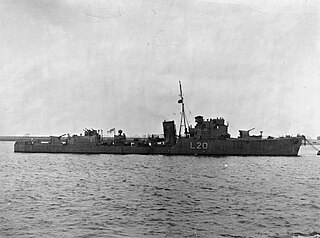
HMS Whaddon (L45) was a Type I Hunt-class destroyer of the Royal Navy built by Alexander Stephen & Sons of Linthouse, Govan and launched on 16 July 1940. She was laid down on 27 July 1939 and commissioned 28 February 1941. She was adopted by the civil community of Newport Pagnell in Buckinghamshire, as part of the Warship Week campaign in 1942.

HMS Wensleydale was a Hunt-class destroyer of the Royal Navy. She was a member of the third subgroup of the class, and saw service in the Second World War. She was adopted by the civil community of Swinton and Pendlebury during Warship Week in 1942. As good luck she carried fox pads from the Wensydale Hounds gifted by the Chapman family of Thronton Rust, Wenslydae.

HMS Wheatland was a Type 2 Hunt-class destroyer of the Royal Navy that served in the Second World War.

The second HMS Vanity was a V-class destroyer of the British Royal Navy that saw service in World War I and World War II.

HMS Onslaught was an O-class destroyer of the Royal Navy which entered service in 1941. She was originally to have been named Pathfinder, but this was changed during construction. She was adopted by the Isle of Wight as part of the Warship Week campaign in 1942. After the Second World War she was sold to Pakistan and scrapped in 1977.

HMS Cattistock (L35) was a Type I Hunt-class destroyer of the Royal Navy. She was a member of the first subgroup of the Hunt class and served throughout World War II before being scrapped in 1957.

HMS Meynell was a Type I Hunt-class destroyer of the Royal Navy which served in World War II. She was sold to Ecuador in 1954 where she served as Presidente Velasco Ibarra.

HMS Quantock was a Type I Hunt-class destroyer of the Royal Navy which served in World War II. She was sold to Ecuador in 1954 where she served as Presidente Alfaro.

HMS Eglinton (L87) was a Type I Hunt-class destroyer of the Royal Navy built by Vickers-Armstrongs on the River Tyne, and launched on 28 December 1939. She was adopted by the town of Alton, Hampshire, as part of the Warship Week campaign in 1942.

HMS Garth was a Type I Hunt-class destroyer of the Royal Navy built by John Brown & Company on the River Clyde, and launched on 28 December 1939. She was adopted by the Civil Community of Wokingham, Berkshire, as part of the Warship Week campaign in 1942.

HMS Holderness was a Type I Hunt-class destroyer of the Royal Navy which served in World War II. She was scrapped in 1956.

HMS Pytchley was a Type I Hunt-class destroyer of the Royal Navy which served in World War II. She was scrapped in 1956.

HMS Southdown was a Type I Hunt-class destroyer of the Royal Navy which served in World War II. She was scrapped in 1956.

HMS Cowdray was a Type II Hunt-class destroyer of the Royal Navy which served in World War II. She has been the only Royal Navy ship to bear the name. She was scrapped in 1959.

HMS Farndale was a Type 2 Hunt-class destroyer of the Royal Navy which served in World War II. She was scrapped in 1962. She has been the only British Warship so far to bear this name.

HMS Wilton was a Type 2 Hunt-class destroyer of the Royal Navy that served in the Second World War.

HMS Lauderdale was a Hunt-class destroyer of the Royal Navy. Ships of this class were designed as cheap, easily built vessels for convoy escort and antisubmarine duties. She was named like her sisters after a fox hunt, in her case one in Berwickshire. War bonds were issued to finance the building of warships. During Warship Week held in 1942 the civil community of Berwickshire adopted the ship. She has been the only Royal Navy warship to carry this name.

HMS Belvoir was a Hunt-class destroyer of the Royal Navy. She was a member of the third subgroup of the class, and saw service in the Second World War. She was adopted by the civil community of Sutton in Ashfield, Nottinghamshire during Warship Week in 1942.

HMS Bleasdale was a Hunt-class destroyer of the Royal Navy. She was a member of the third subgroup of the class, and saw service in the Second World War. All the ships of this class were named after British fox hunts. She was the first Royal Navy warship with this name, after the Bleasdale hunt in Lancashire. In 1942 she was adopted by the civil community of Garstang in Lancashire, as part of Warship Week.
HMS Fernie was a Type I Hunt-class destroyer built for the Royal Navy completed in mid-1940. She was adopted by the Civil Community of Market Harborough, Leicestershire, as part of the Warship Week campaign in 1942. She has been the only ship in the Royal Navy to carry this name.



















